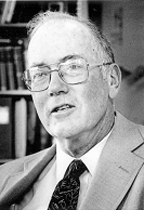Charles H. Townes Honored By ASME for the Invention of Masers and Lasers
Charles H. Townes Honored By ASME for the Invention of Masers and Lasers
 NEW YORK, October 22, 2012 —Charles H. Townes, Ph.D., a resident of Oakland, Calif., and a professor in the Graduate School at the University of California, Berkeley, will be honored by ASME. He is being recognized for the invention of masers and lasers that have dramatically changed the modern world and benefited mankind. He will receive the Nancy DeLoye Fitzroy and Roland V. Fitzroy Medal.
NEW YORK, October 22, 2012 —Charles H. Townes, Ph.D., a resident of Oakland, Calif., and a professor in the Graduate School at the University of California, Berkeley, will be honored by ASME. He is being recognized for the invention of masers and lasers that have dramatically changed the modern world and benefited mankind. He will receive the Nancy DeLoye Fitzroy and Roland V. Fitzroy Medal.
The medal, established in 2011,recognizes pioneering contributions to the frontiers of engineering leading to a breakthrough(s) in existing technology or leading to new applications or new areas of engineering endeavor. It will be presented to Dr. Townes during the 2012 International Mechanical Engineering Congress and Exposition which is being held in Houston, Nov. 9 through 15.
Townes joined the faculty at the University of California, Berkeley, in 1967. Initially a professor of physics, he has been a professor in the Graduate School since 1994.
Among his prior experience, Townes was provost and professor of physics at the Massachusetts Institute of Technology, Cambridge (1961-66); a professor at Columbia University, New York (1947-61); and a member of the technical staff (1939-47) at Bell Telephone Laboratories (Berkeley Heights, N.J.).
His accomplishments include the invention of masers and lasers. In 1951, he realized that stimulating molecules with microwaves and amplifying the effect in a special chamber could produce an unusually pure, concentrated beam of radiation. Three years later, he and his graduate students fired up a machine that produced the desired beam and called it a MASER (microwave amplification by stimulated emission of radiation). Today, the principal maser application is the hydrogen maser, which is used as an atomic frequency standard. The laser is widely used in countless applications in every area of modern society including consumer electronics, manufacturing, information technology, science, medicine, industry, law enforcement, entertainment and the military.
Townes is currently studying the properties of stars and immediate stellar environments in the mid-infrared portion of the spectrum through the use of three specially designed movable telescopes.
An ASME Fellow, Townes is also a member of the National Academy of Engineering (NAE), the American Physical Society, the Optical Society of America, the Max Planck Institute for Physics and the Max Planck Institute for Astrophysics, among others.
His extensive list of honors includes the Nobel Prize in Physics (1964) from the Royal Swedish Academy of Sciences, a National Medal of Science (1982) presented by U.S. President Ronald Reagan, NAE’s Founders Award (2000), RAS’ Lomonosov Gold Medal (2000), the Astronomische Gesellschaft’s Karl Schwarzschild Medal (2002), the John Templeton Foundation’s Templeton Prize (2005), the National Science Board’s Vannevar Bush Award (2006) and the Gold Medal (2010) from SPIE, the International Society for Optics and Photonics.
Townes earned bachelor’s degrees in physics and in modern languages from Furman University (Greenville, S.C.) in 1935. He earned his master’s degree in physics from Duke University (Durham, N.C.) in 1937. In 1939, he earned his Ph.D. in physics from the California Institute of Technology, Pasadena. Townes has received 31 honorary degrees.
About ASME ASME helps the global engineering community develop solutions to real world challenges. Founded in 1880 as the American Society of Mechanical Engineers, ASME is a not-for-profit professional organization that enables collaboration, knowledge sharing and skill development across all engineering disciplines, while promoting the vital role of the engineer in society. ASME codes and standards, publications, conferences, continuing education and professional development programs provide a foundation for advancing technical knowledge and a safer world. For more information visit www.asme.org.



